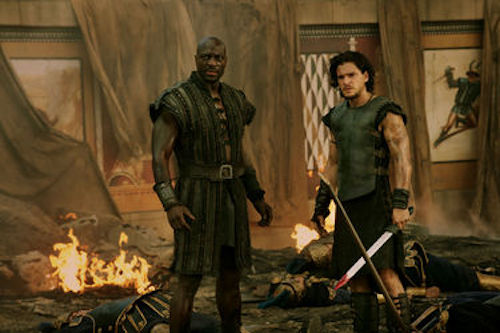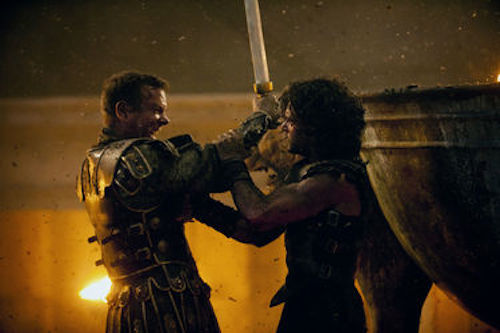Synopsis: A slave must battle for his freedom while Mount Vesuvius threatens to blow and destroy everything, including his true love.
Release Date: February 21, 2014 MPAA Rating: PG-13
Genre(s): Action,
Film Review

Production
True-life disaster movies are a tough thing for a filmmaker to attempt. There’s little mystery in historical dramas like Titanic or St. Helens, so the challenge becomes finding a way for the movie to hold the attention of an audience who knows how the story is going to end. This is the task that director Paul W.S. Anderson (Event Horizon, the Resident Evil movies) tries to tackle in Pompeii.
Pompeii is a Roman township at the base of Mount Vesuvius, a large active volcano in ancient Italy. Seventeen years after helplessly watching Roman soldiers slaughter his family, a slave named Milo (Kit Harington from “Game of Thrones”) is sent to Pompeii to fight for his life as a gladiator. On the way, he happens to meet the lovely Cassia (Sucker Punch‘s Emily Browning), a young woman with whom he instantly falls in love. Unfortunately, Milo is scheduled to fight a champion gladiator named Atticus (Adewale Akinnuoye-Agbaje from “Lost”), a slave who is promised freedom after he wins one more fight. Fortunately, Milo is a skilled and ruthless fighter as well, and promises to be a challenging opponent. Meanwhile, Cassia’s parents, Severus (Jared Harris from Sherlock Holmes: A Game of Shadows) and Aurelia (The Matrix‘s Carrie-Anne Moss), have promised her hand in marriage to Senator Corvus (Kiefer Sutherland, television’s own Jack Bauer from “24”) in exchange for financial support from the Empire. Milo recognizes Corvus as the man responsible for his family’s murders, and enlists Atticus to help him gain his revenge. While all of this is going on, Mount Vesuvius continues to rumble, threatening to erupt and annihilate the city. Milo has to enact his revenge and save Cassia from marrying Corvus before the volcano wipes everything out.

There are actually a number of different things going on in Pompeii, and that’s one of its problems. The film starts out as a typical gladiator revenge film. Once Milo meets Cassia, it continues as a star-crossed-lovers type of story. Corvus’ pressure on Severus has elements of a political thriller. And, when the volcano finally does blow, it turns into a full-on disaster movie. It’s all there, but the script really doesn’t do any of it well. The screenplay was written by Janet Scott Batchler and Lee Batchler (the husband/wife writing team behind Batman Forever) along with Michael Robert Johnson (Sherlock Holmes), and it may be a case of too many cooks in the kitchen. The film lacks focus in the story and the characters are complete stock archetypes. Once the film gets rolling, the events just get more and more improbable and the dialogue gets stupider and stupider, almost as if the writers are as bored with the plot as the audience is. After a while, the viewer can’t wait for that volcano to spew molten rock down on the whole thing.

For his part, Paul W.S. Anderson tries his best to salvage it, and it isn’t a complete waste – just a partial one. With the laughable lines that the actors are forced to deliver, the acting becomes hit-and-miss; Harington and Akinnuoye-Agbaje are hits, Browning and Sutherland not so much. The visual effects are also a mixed bag, looking really cool during the eruption and battle scenes, but falling flat everywhere else. The 3D is unnecessary for the most part as well, only being utilized to its full potential once Vesuvius starts spewing. The whole film looks like Anderson phoning in an apology for how bad the script is; it’s basically a watered-down Gladiator with the addition of a rumbling volcano as a ticking bomb.

Action Sequences
The one element of Pompeii that tries to keep it interesting is the fight scenes. They’re actually pretty awesome. They owe obvious debts to both Gladiator and the arena scene in Star Wars Episode II: Attack of the Clones, but they are also original in and of themselves. The battles are highly choreographed and, although a bit CG-heavy at times, are very well executed. It helps that the most sympathetic characters – Milo and Atticus – are the ones who do much of the fighting, because the audience is somewhat invested in them. When they win, the viewer wants to cheer. When they are hurt, the viewer wants to cringe. And, when they are double-crossed, the viewer wants to get angry. If the rest of the film had as much energy and emotion as the fight scenes, Pompeii would be a much better film. It doesn’t, so it isn’t.

Cast and Crew
- Director(s): Paul W.S. Anderson
- Producer(s):
- Screenwriter(s): Janet Scott BatchlerLee BatchlerMichael Robert Johnson
- Story:
- Cast: Kiefer Sutherland (Corvus)Sasha Roiz (Proculus)Kit Harington (Milo) Emily Browning (Cassia)Carrie-Anne Moss (Aurelia)
- Editor(s):
- Cinematographer: Glen MacPherson
- Production Designer(s):
- Costume Designer:
- Casting Director(s):
- Music Score: Clinton Shorter
- Music Performed By:
- Country Of Origin: USA